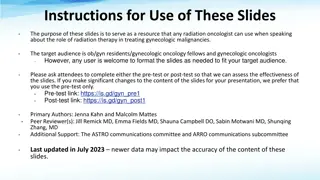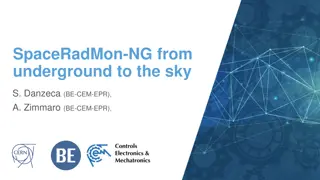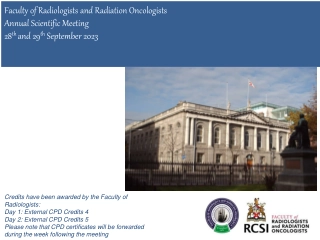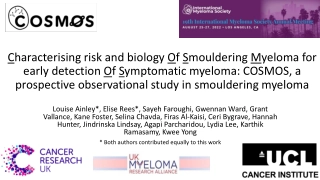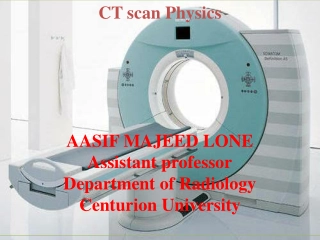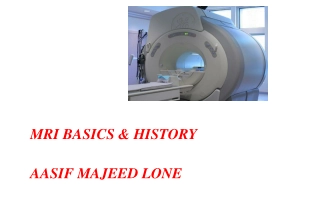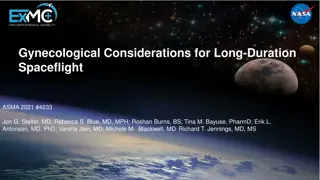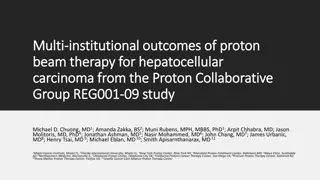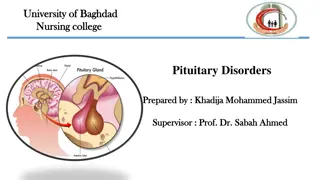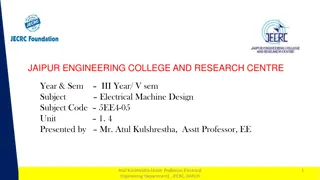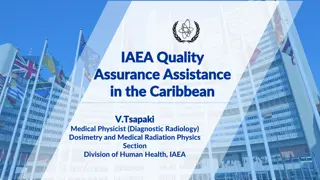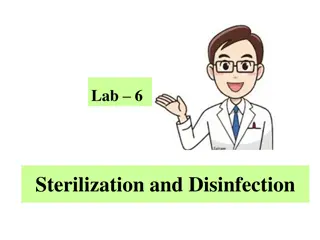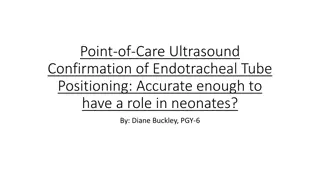RADIATION BIOLOGY
Radiobiology is the study of how ionizing radiation impacts living organisms. It involves direct and indirect effects on biological molecules, leading to the formation of free radicals that can cause cellular damage. The process includes the radiolysis of water, generation of hydrogen peroxide, and interaction with organic molecules. These effects account for two-thirds of radiation-induced biological damage.
Download Presentation
Please find below an Image/Link to download the presentation.
The content on the website is provided AS IS for your information and personal use only. It may not be sold, licensed, or shared on other websites without obtaining consent from the author. Download presentation by click this link. If you encounter any issues during the download, it is possible that the publisher has removed the file from their server.
Presentation Transcript
DEFINITION Radiobiology is the study of the effects of ionozing radiation on living systems
RADIATION CHEMISTRY Direct effect when energy of a photon or secondary electron ionizes biologic macromolecules Indirect effect a photon may be absorbed by water in an organism, ionizing some of its water molecules. The resulting ions form free radicals that in turn interact with and produce changes in biologic molecules
DIRECT EFFECT Biologic molecules absorb energy from ionizing radiation and form unstable free radicals Generation of free radicals occurs in less than 10 sec after interaction with a photon Free radicals are extremely active and have very short lives, quickly reforming into stable configurations by dissociation or cross-linking
DIRECT EFFECT RH + x-radiation R + H + e Free radical fate Dissociation: R X + Y Cross linking: R + S RS Approx one third of biologic effects of x ray exposure results from direct effects
RADIOLYSIS OF WATER photon + H O This is a complex procedure, on balance water is largely converted to hydrogen and hydroxyl free radicals When dissolved oxygen is present in irradiated water, hydroperoxyl free radicals may also be formed H + O HO H + OH
Hydroperoxyl free radicals contribute to formation of hydrogen peroxide in tissues HO + H H O HO + HO O + H O Both peroxyl radicals and hydrogen peroxide are oxidising agents and are the primary toxins produced in tissues by ionizing radiation
INDIRECT EFFECT In this both hydrogen and hydroxyl free radicals interact with organic molecules resulting in formation of organic free radicals Two thirds of radiation induced biologic damage results from indirect effects RH + OH R +H O RH + H R + H Such reactions may involve the removal of hydrogen
OH free radical is more important in causing such damage Organic free radicals are unstable and transform to form into stable, altered molecules These altered molecules have different chemical and biologic properties from the original molecules
CHANGES IN DNA This is the primary cause of radiation induced cell death, heritable mutations and cancer formation Radiation produces different types of alterations, Breakage of one or both DNA strands Cross-linking of DNA strands within the helix to other DNA strands or to proteins Change or loss of a base Disruption of hydrogen bonds b/w DNA strands 1. 2. 3. 4.
DETERMINISTIC AND STOCHASTIC EFFECTS Deterministic effects radiation injury to organisms results from killing of no of cells Severity of clinical effects is proportional to dose The greater the dose, the greater the effect Probability of effect independent of dose Stochastic effects sublethal damage to individual cells that results in cancer formation or heritable mutation Severity of clinical effects is independent of dose Shows all or none response, an individual either has effect or does not Frequency of effect proportional to dose Greater the dose, greater the chance of effect
DETERMINISTIC EFFECTS ON CELLS Effects on intracellular structures On nucleus Chromosomes aberrations Effect on cell replication
EFFECTS ON INTRACELLULAR STRUCTURES Results from radiation induced changes in their macromolecules These changes are manifest initially as structural and functional changes in cellular organelles The changes may cause cell death
ON NUCLEUS Nucleus is more radiosensitive than cytoplasm, specially in dividing cells Sensitive site in nucleus is DNA within chromosomes
CHROMOSOMES ABERRATIONS Chromosomes serve as useful markers for radiation injury, and extent of their damage is related to cell survival It is seen in irradiated cells at the time of mitosis when the DNA condenses to form chromosomes It is dependent on stage of cell in cell cycle at the time of irradiation
Chromatid abberation - If radiation exposure occurs after DNA synthesis, in G2 or mid or late S, only one arm of affected chromosome is broken Chromosome abberation - If radiation induced break occurs before DNA has replicted, in G1 or early S phase, the damage manifests as a break in both arms
EFFECT ON CELL REPLICATION Radiation to rapidly dividing cell systems will cause a reduction in size of irradiated tissue as a result of mitotic delay and cell death Reproductive death loss of capacity for mitotic division in a cell population The three mechanisms of reproductive death are DNA damage, bystander effect, and apoptosis
DNA DAMAGE Cell death is caused by damage to DNA, which inturn causes chromosome abberations, which cause the cell to die during the first few mitosis after irradiation It is the rate of cell replication in various tissues and thus the rate of reproductive death In a sample of slowly dividing cells is irradiated, larger doses and longer time intervals are required for induction of deterministic effects
BYSTANDER EFFECT Cells that are damaged by radiation and release molecules into their immediate environment that kill nearby cells This effect causes chromosome abberations, cell killing, gene mutations and carcinogenesis
APOPTOSIS Also known as programmed cell death, occurs during normal embryogenesis Cells round up, draw awayfrom their neighbors and condense nuclear chromatin This can be induced in both normal tissue and in some tumors It is most common in hemopoietic and lymphoid tissues
RECOVERY Cell recovery from DNA damage and bystander effect involves enzymatic repair of single strand breaks of DNA So, a higher total dose is required to achieve a given degree of cell killing when multiple fractions are used
RADIOSENSITIVITY AND CELL TYPE Most radiosensitivity cells have foll characteristics A high mitotic rate Undergo many future mitoses Are most primitive in differentiation
RELATIVE RADIOSENSITIVITY Characteristi cs HIGH: Divide regularly, Long mitotic figures, Undergo no or little differentiation b/w mitosis INTERMEDIAT E: Divide occasionally in response to demand for more cells LOW: Highly differentiated, when mature are incapable of division Examples Spermatogenic and erytroblastic stem cells, Basal cells of OMM Vascular endothelial cells, fibroblasts, acinar and ductal salivary gland cells, parenchymal cells of liver, kidney and thyroid Neurons, striated mm cells, squamous ept cells, erythrocytes
DETERMINISTIC EFFECTS ON TISSUES AND ORGANS Short term effects on tissue is determined primarily by sensitivity of its parenchymal cells When continuously proliferating tissues are irradiated with moderate dose, cells are lost primarily by reproductive death, bystander effect and apoptosis Extent of cell loss depends on damage to stem cell pools and proliferative rate of cell population Effect becomes apparent as a reduction in no of mature cells in a series
DETERMINISTIC EFFECTS ON TISSUES AND ORGANS Long term effects: results in loss of parenchymal cells and replacement of fibrous connective tissue This is caused by reproductive death of replicating cells and by damage to fine vasculature Damage to capillaries leads to narrowing and eventually obliteration of vascular lumens This impairs the transport of oxygen, nutrients and waste products and results in death of all cell types Thus both dividing and non dividing parenchymal cells are replaced by fibrous connective tissue, a progressive fibroatrophy of the irradiated tissue
MODIFYING FACTORS The response of cells, tissues and organs depends on exposure conditions and cell environment Dose Dose rate Oxygen Linear energy transfer
DOSE Severity of deterministic damage is dependent on amount of radiation received In all individuals, receiving doses above threshold level, the amount of damage is proportional to dose
DOSE RATE Dose rate indicates the rate of exposure Exposure to a dose at a high dose rate causes more damage than exposure to the same total dose given at a lower dose rate Low dose rate allows for opportunity to repair the damage
OXYGEN The radioresistance of many biologic systems increases by a factor of 2 or 3 when exposure is made with reduced oxygen The cell damage in the presence of oxygen is related to formation of hygrogen peroxide and hydroperoxyl free radicals It is important coz hyperbaric oxygen therapy may be used during radiation therapy of tumors having hypoxic cells
LINEAR ENERGY TRANSFER The dose required to produce a certain biologic effect is reduced as the LET of the radiation is increased Thus, higher LET radiations are more efficient indamaging biologic systems coz their high ionization density is more likely than x rays to induce double strand breakage in DNA Low LET radiations such as x rays deposit their energy in the absorber and thus are more likely to cause single strand breakage and less biologic damage
RADIOTHERAPY IN THE ORAL CAVITY Effect on oral tissues Oral mucous membrane Taste buds Salivary glands Teeth Radiation caries Bone Musculature 1. 2. 3. 4. 5. 6. 7.
RATIONALE Fractionation of the total x ray dose into multiple small doses provides greater tumor destruction than is possible with a large single dose Fractionation allows for increased cellular repair of normal tissues, also allows for increasing the mean oxygen tension in irradiated tumor, rendering the tumor cells radiosensitive Results in killing rapidly dividing tumor cells and shrinking the tumor mass after first few fractions, reducing the distance that oxygen must diffuse from fine vasculature through tumor to reach remaining viable tumor cells
EFFECT ON ORAL MUCOUS MEMBRANE It contains a basal layer of rapidly dividing, radiosensitive stem cells Near the end of 2ndweek of therapy, as some cells die, mm begins to show areas of redness and inflammation As therapy continues, mm begins to separate from underlying CT, with formation of white to yellow pseudomembrane At end of therapy, mucositis is most severe, discomfort is at maximum, and food intake is difficult Topical anesthetics may be required at meal time Complication: secondary yeast infection by C . Albicans
After irradaition is complete, mucosa begins to heal rapidly Healing is usually complete by about 2 months Later, mm tends to become atrophic, thin, & relatively avascular This long term atrophy results from progressive obliteration of the fine vasculature and fibrosis of the underlying CT These changes complicate denture wearing coz they cause oral ulcerations of compromised tissue
TASTE BUDS Are sensitive to radiation Therapeutic dose cause extensive degeneration of the histologic architecture of taste buds Pts often notice a loss of taste acuity during 2ndor 3rd week of radiotherapy Bitter and acid flavors are more severly affected when posterior 2/3rdof tongue is irradiated Salt and sweet is lost when anterior 1/3rdis irradiated Taste acuity decreases by a factor of 1000 to 10,000 during radiotherapy course Taste loss is reversible and recovery takes 60 to 120 days
SALIVARY GLANDS Parenchymal component of salivary gland is radiosensitive A marked and progressive loss of salivary secretion is usually seen in the first few weeks after initiation of radiotherapy Extent of reduced flow is dose dependent and reaches zero at 60 Gy Mouth becomes dry and tender and swallowing is difficult and painful Pts with irradiation of both glands are more likely to c/o dry mouth and difficulty with chewing and swallowing
Serous cells are more rsensitive than mucous cells and residual saliva is more viscous The saliva has a reduced pH, 1 unit less This pH is sufficient to cause decalcification Buffering capacity of saliva falls as much as 44% If some portions of salivary gland are spared, dryness usually subsides in 6 to 12 months coz of compensatory hypertrophy In months later, inflammatory response become s chronic and glands demonstrate progressive fibrosis, adiposis, loss of fine vasculature and concommitant parenchymal degeneration
TEETH Childrens subjected to radiation therapy may show defects in permanent dentition such as retarded root development, dwarfed teeth or failure to form one or more teeth If exposure precedes calcification, irradiation may destroy the tooth bud Irradiation after calcification has begun may inhibit cellular differentiation, causing malformations and arresting general growth Eruptive mechanism is totally r resistant
RADIATION CARIES It is a rampant form of dental decaypts receiving r therapy show acidogenic saliva and plaque and show an increase in S mutans, Lactobacillus and Candida Caries is due to reduced salivary flow, decreased pH, reduced buffering capacity, increased viscosity and altered flora Reduced saliva has a low concentration of Ca , resulting in greater solubility of tooth structure and reduced remineralization
3 TYPES OF RADIATION CARIES Widespread superficial lesions attacking buccal, occlusal, incisal and palatal surfaces Another type involves primarily the cementum and dentin in cervical region. These lesions may progress circumferentially and result in loss of crown Last type, appears as a dark pigmentation of the entire crown, incisal edges may be markedly worn
TREATMENT Daily application for 5 minutes of viscous topical 1% neutral NaF gel in custom made applicator trays Use of topical fluoride causes a 6 month delay in irradiation induced elevation of S. mutans Restorations, excellent oral hygiene, cariogenic food restriction and NaF application Grossly carious or periodontally involved teeth are extracted before irradiation
BONE Primary damage to mature bone results from radiation induced damage to vasculature of periosteum and cortical bone Radiation also acts by destroying osteoblasts and to a lesser extent osteoclasts Normal marrow may be replaced with fatty marrow and fibrous CT The marrow becomes hypovascular, hypoxic and hypocellular The endosteum becomes atrophic, showing a lack of osteoblastic and osteoclastic activity
Reduced degree of mineralization leading to brittleness When these changes are so severe that bone death results and bone is exposed osteoradionecrosis Osteoradionecrosis is the most serious clinical complication The decreased vascularity of mandible renders it easily infected by microorganisms from the oral cavity
This bone infection results from radiation induced breakdown of oral mucous membrane, by mechanical damage to the weakened mm such as from a denture sore or tooth extraction, through a periodontal lesion or radiation caries More common in mandible than maxilla
MUSCULATURE Radiation may cause inflammation and fibrosis resulting in contracture and trismus in muscles of mastication Usually masseter or pterygoid mm are involved Restriction in mouth opening usually starts about 2 months after radiotherapy is completed and progresses thereafter An exercise program may be helpful in increasing opening distance
DETERMINISTIC EFFECTS OF WHOLE BODY IRRADIATION Acute Radiation Syndrome: It is a collection of signs and symptoms experienced by persons after acute whole body irradiation DOSE (Gy) 1 to 2 2 to 4 MANIFESTATION Prodormal symptoms Mild hematopoietic symptoms Severe hematopoietic symptoms Gastrointestinal symptoms CVS & CNS symptoms 4 to 7 7 to 15 50
PRODORMAL PERIOD Within the first few minutes to hours after exposure to whole body irradiation of about 1 .5 Gy an individual experiences anorexia, nausea, vomitting, diarrhea, weakness and fatigue The higher the dose, the more rapid the onset and the greater the severity of symptoms
LATENT PERIOD A period of well being during which no signs and symptoms of radiation sickness occurs This period extends from hours or days after supralethal exposures to a few weeks after exposure
HEMATOPOIETIC SYNDROME Whole body exposures of 2 to 7 Gy cause injury to the hematopoietic stem cells of bone marrow and spleen The high mitotic activity of these cells makes bone marrow a highly radiosensitive tissue Doses in this range cause a rapid fall in the nos of circulating granulocytes, platelets and finally erythrocytes
Clinical signs includes infection, hemorrhage and anemia Death from hematopoietic syndrome occurs in 10- 30 days after irradiation



